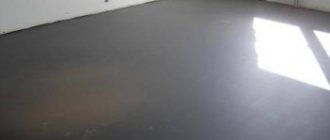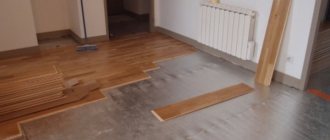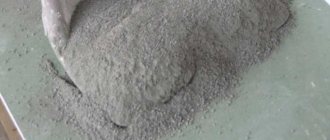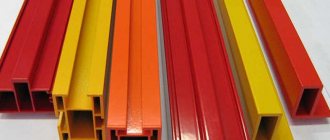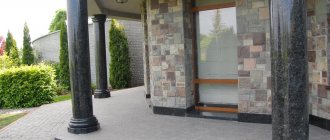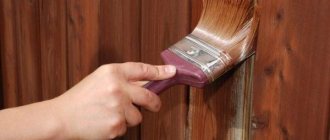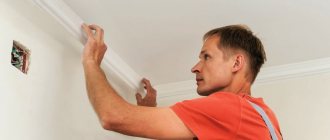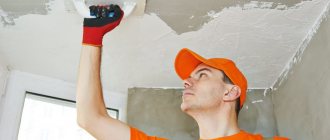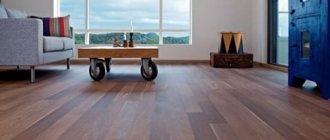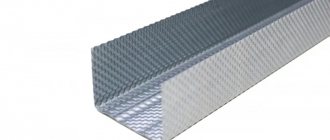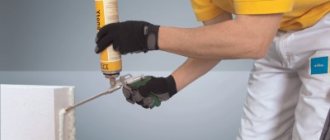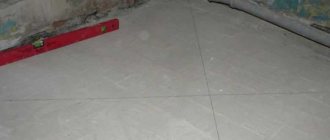Self-leveling polymer floors are also called “liquid linoleum” - they are so comfortable to use. This is a new word in interior design, and simply a godsend for industrial premises. They add additional visual volume to any interior thanks to their soft shine and seamless surface. Minimal shrinkage, high elasticity and modern aesthetics - these are the qualities thanks to which polymer floors are now gaining more and more popularity in the CIS countries, and abroad they have long been number one on the market.
- 2 Self-leveling floor: revealing the secrets of technology
- 3 Technical characteristics of the coating
- 4 What does the market offer?
- 5 Do-it-yourself pouring - how realistic is it?
- 6 How to care for self-leveling floors?
general information
The poured floor appeared on the building materials market relatively recently. Before reaching private apartments and houses, self-leveling self-leveling flooring has gone through a difficult journey. Initially, this building material was intended for use under suspended loads. Such floors were poured in shopping centers, laboratories and industrial premises.
Such places are characterized by increased demands on the floor covering in terms of wear resistance. Ultimately, the introduction of new materials and the development of the technological process for producing floor mixtures made it possible to use it in residential premises.
Quite often, people who have little understanding of the issue confuse self-leveling floors and screeds with the self-leveling effect. Meanwhile, leveling the floor with a self-leveling mixture is the final correction of the surface before laying the topcoat. They can be used - laminate, linoleum, tiles, parquet, self-leveling flooring and so on.
Materials from Sika
The range of Sika construction chemicals for flooring includes polymer-cement dry mixtures for leveling and preparing the base for finishing coating, one-, two- and three-component polymer floors, primers and protective varnish coatings. Materials can be used as:
- finishing self-leveling floors;
- thin- and thick-layer polymer screeds for leveling cement-sand and concrete bases.
Among the advantages of Sika self-leveling floors are:
- quick set of required strength;
- self-leveling ability;
- economical consumption;
- simplicity and ease of use.
For questions regarding the purchase of Sika polymer floors, please contact our official dealers and regional representatives, whose telephone numbers are listed on the website in the “Contacts” section.
Types of self-leveling floor
Self-leveling floor mixtures are currently the most widely used. They can be found ranging from factory premises to cozy apartments. In many ways, when choosing a self-leveling coating, one is guided not only by the desired strength, but also by the material from which the base of the mixture for pouring is made. There are several basic modifications of self-leveling floors.
Liquid floor perfectly levels any surface Source vyboroved.ru
Polyurethane
This coating is based on polyurethane. This material is characterized by increased resistance to compression and tension. It is also characterized by the following qualities:
- resistance to chemical environments;
- resistance to mechanical loads;
- elasticity.
Due to its great flexibility, cracks do not form on the material. This floor is used both in industrial buildings and in buildings intended for public use. The composition is applied to almost any surface, from:
- concrete;
- wood;
- metal
During operation it shows increased resistance to wear.
Epoxy
Epoxy self-leveling flooring has a special resin as its main composition, which is activated by a hardener. Epoxy resin flooring is much harder than polyurethane flooring. This factor makes the epoxy floor somewhat less resistant to impact loads. Floor coverings made of this material are installed in places with high traffic, usually public buildings.
Meanwhile, such floors are becoming increasingly popular in private construction. This is explained by the wide range of colors and the ability to fill in various patterns. The final surface can be glossy or matte. However, working with this material requires a certain professionalism and experience.
Self-leveling polyurethane floor screed Source otdelkagid.ru
Epoxy-urethane
This type of self-leveling floor combines the best qualities of epoxy compounds and polyurethane. The final coating is not only resistant to impact loads, but also has excellent resistance to chemical environments.
In addition, the combination of the main components allows you to fill not only in closed locations, but also in the open air. The combination of great durability and resistance to temperature changes makes these compounds very popular among consumers.
Methyl methacrylate
This polymer self-leveling floor is characterized by an increased pouring speed. In just a couple of hours you can create excellent coverage. The composition hardens in about an hour, and the final strength gain occurs within two hours.
This material is practically not inferior to compositions made from polyurethane or epoxy resin. Moreover, it surpasses them in resistance to sub-zero temperatures. You can install flooring even in the relatively cold season.
However, methyl methacrylate flooring also has its disadvantages:
- taking into account the specific nature of the work, only highly qualified workers can do it;
- high price for this type of coating;
- During work, harmful substances are released and good ventilation is required.
These negative qualities are quite conditional and if you need to carry out work in the shortest possible time, then this coating is the optimal solution.
Polymer self-leveling floor Source stroychik.ru
Cement-acrylic
In this type of coating, the base is a poly-acrylic polymer with a quartz filler. The finished floor practically does not slip when walking. For this reason, such coatings are installed in locations with high humidity:
- car washes;
- swimming pools;
- bathrooms;
- saunas.
One of the main advantages of cement-acrylic coatings is the ability to fill a fairly thick layer - up to 12 millimeters. This allows you to install floors while minimizing preparatory work to level the base. We should not forget about the excellent adhesion of these compounds, which maintain integrity even in the presence of cracks in the base.
See also: Catalog of construction companies that specialize in finishing and paint materials
Applying a layer of polymer coating
Polymer self-leveling flooring up to 5 mm is applied in one layer.
The highly filled polymer floor is applied in two layers. The first layer of self-leveling floor is applied with a spatula after mixing the two components, first along the perimeter of the room, near columns, niches and other obstacles. The self-leveling floor is applied to the remaining surface as a spill and leveled with a wide squeegee. Application is carried out on a layer of uncured primer.
- After curing, the first layer of highly filled polymer flooring is processed into a mosaic pattern using sanding machines. Dust from grinding is removed.
- The top layer of a highly filled polymer floor is a protective decorative layer. Usually it is colored.
- In large rooms, at the final stage, expansion joints are cut and sealed with polymer polyurethane sealant.
Choosing a self-leveling floor
When choosing a liquid floor, first of all, the location where it is poured is taken into account. Based on this indicator, preference is given to one or another composition. For example, mixtures made of epoxy resin or polyurethane are most suitable for residential buildings. At the same time, pouring epoxy floors is used in bathrooms, given the high resistance to moisture of such coatings.
3D floor in the bathroom Source dekoriko.ru
For rooms intended for direct living, it is better to use polyurethane mixtures. The thickness of the fill should be within two millimeters. A thinner coating will be less resistant to abrasion, and a thick one will incur unnecessary costs.
Separation by appearance
According to this parameter, self-leveling floors are usually divided into three main categories:
- plain;
- with patterns;
- 3D.
The first type of flooring is available on the market in a wide variety of color shades. The surface can be matte or glossy and they blend easily into any decor. Patterned floors come with pre-made stencils. You can also order an individual drawing or do it yourself.
3D floors create the illusion of a three-dimensional image and two main methods are used for this:
- printing the design on vinyl film;
- applying the image to a previously prepared base using acrylic paints.
Using film when pouring 3D floors is less labor-intensive and much cheaper than the second method.
Finish floor
This concept deserves special attention, since without clarification of specific details, it causes some confusion. To avoid this, it is necessary to distinguish between leveling the base and filling the floor itself. If, after applying the cement screed, a liquid floor is poured, then it can be called finishing. However, as a rule, a finishing coating in the form of linoleum or other material is laid on the cement screed.
3D floor in the living room Source delaypol.com
When pouring a self-leveling floor, many of its varieties require application in several layers. For example, a floor with a picture is applied in the following order:
- base;
- drawing;
- protective covering.
Based on this, such a floor can have its own finishing layer.
Common mistakes
It is very important to try to avoid the following mistakes when performing pouring work.
- If you did not dry the base properly before pouring, allow grease stains to appear or leave dust, the floor will begin to peel off in layers when a certain amount of force is applied. If you notice this phenomenon throughout the coating, you will need to remove it. If only a few areas are affected, you can re-flood them. If you allow debris to get in, get rid of it after the composition has hardened using simple sandpaper.
- You should be very careful about the amount of water in the mixture. When there is not enough of it, lumps will begin to form; if there is too much, the quality and strength of the polymer will decrease.
It is important to carefully monitor how much water has been added to the mixture - both excess and deficiency can affect the quality of the floor
- It is very important to be aware of this mistake, which can be very costly for people pouring polyurethane floors. In hot weather, after finishing mixing the mixture, you are literally distracted for a few minutes, and as soon as you return to work, you will find a tightly frozen mass. Of course, the instructions say that hardening occurs in 20 minutes, but in the heat everything can happen faster. Many novice masters make precisely this omission. So in the heat it is better not to work with compounds. At normal temperatures, it is better to immediately place the mass in the application area.
It is worth saying that during the process of pouring the floor, a nasty smell will most likely arise, which will disappear after a couple of hours.
Self-leveling floor device
The base for pouring can be a concrete screed, a floor made of metal, wood or ceramic tiles. The main thing is that the base is relatively smooth and free of unnecessary coatings in the form of paint, varnishes and the like.
Base
To use a liquid floor to level a concrete floor, the base is prepared, it is carried out in several stages:
- the recesses are sealed with cement mixture;
- the cracks are opened and also filled with the mixture;
- the projections are cut down and sanded;
- thorough cleaning of dust is carried out;
- a primer layer is applied to increase adhesion;
- If not all the pores of the base are filled, after the first layer of primer has dried, apply the next one.
After the preparatory work, they begin pouring.
Do-it-yourself pouring - how realistic is it?
Absolutely real. After all, the self-leveling floor adheres tightly to any base: tiles, concrete and even wood. The only main thing is that it is clean, dried, smooth and grease-free. The total moisture content of the base should not exceed 5%.
So, after you put the mixture on the floor, it will begin to spread and take on a perfectly horizontal level. Your only task is to ensure that no air bubbles appear anywhere - and for this they use a studded roller.
And you can place any objects to create a fashionable 3D floor right at the finishing stage: lay it out on a thin layer of polymer varnish and fill it all over again.
Read more in the articles:
- How to make a self-leveling floor with your own hands: all the intricacies of device technology
- Self-leveling epoxy floors: review of technology + brief educational program on installation
- Self-leveling polyurethane floors: overview of pouring methods and design tips
Calculation of self-leveling floor consumption
The price of mixtures for self-leveling floors can reach significant values. For this reason, it is very important to correctly calculate the required amount of composition. This will help not only to carry out work in compliance with technology, but also to save the budget from unjustified expenses. Calculations are made based on the consumption of self-leveling floor per 1 square meter and taking into account the specific nuances of the room.
Self-leveling floor with an abstract marbled pattern Source masterskayapola.ru
Video description
About calculating the amount of mixture for a self-leveling floor in the video:
Final calculations
As a rule, provided that the base is well prepared, calculations are made based on the data specified by the manufacturer of the self-leveling floor. As an example, we will give the procedure for calculating the required amount of mixture to fill a layer of 2.5 millimeters. At the same time, the manufacturer indicated that for 1 millimeter, when pouring 1 square meter, 1.5 kilograms of the composition are needed. The calculation requires three steps:
- The area of the filled plane is calculated. With the correct geometry, it is enough to multiply the width of the room by its length. Complex contours are divided into rectangular sectors and their area is summed up.
- The required thickness is determined using a level. In the case of a relatively flat surface, you can use a standard or laser building level. In case of significant deviations in height, it is necessary to use a water level.
- All received data is recorded and double-checked.
Let's assume that the width of the room is 4.7 meters and the length is 5.9 meters. Therefore, the area of the room will be:
As mentioned above, it is planned to pour a layer of 2.5 millimeters at a mixture consumption of 1.5 kilograms per millimeter. So per square meter you will need:
For the entire room:
When calculating, it is necessary to take into account the density of the composition. We provided approximate indicators for this parameter above, but for more accurate calculations you should check the data provided by the manufacturer.
Self-leveling floor with colonial-style ornaments Source polsdelat.ru
Installation technology
Although the self-leveling floor does not create any particular difficulties in operation, it is necessary to strictly follow the manufacturer’s instructions; even minor violations may result in the need to dismantle the expensive cladding that has “reared up on its hind legs.” Installation is carried out in several stages.
Preparing the base
Depending on the brand, self-leveling mixtures can be used on wooden, concrete and slab bases after appropriate finishing.
Wooden floor - boards are checked for strength, if necessary, weakened segments are cut out and replaced. The baseboard is dismantled, the previous coating is cleaned off, small cracks are sanded to open, the cracks are sealed with a repair mixture. Checking the moisture content of the base is mandatory. It should not exceed 10%, otherwise defects may appear in the future. All dirt and dust are removed, and if necessary, the wood is degreased. The last step is to treat the surface with a deep penetrating compound. The primer will not only ensure adhesion of the composition to the base, but also seal the canvas.
Concrete base - when it comes to repair work, the previous coating is removed, the surface is cleaned of dust and debris. If work is carried out on a fresh screed, the level is measured, the protrusions are chipped off, cracks and potholes are repaired. At least 28 days must pass from the moment the screed is poured to the level or decorative coating is poured. As with wood floors, the moisture level of the substrate must be maintained, with most mixtures requiring a standard of 4%.
VadimXL7FORUMHOUSE Member
Don't neglect humidity. If you start pouring the polymer ahead of schedule, problems cannot be avoided. Of course, pay attention to the manufacturer's recommendations. There are materials with a humidity tolerance of 5-12%, and there are also vapor-permeable ones, where the humidity is not regulated (such floors are matte). It is better to control humidity with a moisture meter.
If you don’t have a special device at hand, VadimXL7 suggests using a proven method - a piece of plastic film measuring 1x1 meter. It is glued to the floor with tape for a day. If, after tearing off, there is moisture on the film, or the concrete has darkened due to moisture, pouring is postponed until both the film and the concrete remain dry. At the end of the preparation, the surface, cleared of dust and contaminants, is thoroughly primed.
Tiles - there is no need to dismantle the entire coating; it is enough to strengthen the peeling elements, clean the surface of dirt and prime it.
In addition to standard preparation, when it comes to pouring a polymer floor over a screed or self-leveling leveler, VadimXL7 advises using a grinder, or at home, a regular grinder with an attachment. This is done to remove the “milk” and open the pores, after which the surface is vacuumed and primed.
The choice of primer depends on the type of self-leveling floor that will be poured; for a polyurethane floor, polyurethane primer; for an epoxy floor, epoxy primer.
For highly porous substrates, several layers of soil are applied; the room must be ventilated so that the humidity does not increase. The primer is applied with a roller to the main surface and with a wide brush in corners and hard-to-reach places.
To increase sound insulation and prevent adhesion of the self-leveling floor to the walls, which can lead to deformation, a damper tape is used, as when performing a dry screed. Its width must be no less than the layer being poured; the remains are cut off after the composition has hardened.
Preparing the mixture
Manufacturers indicate exact instructions on containers with mixtures. Do not violate the proportions: if you exceed the specified amount of water, the characteristics of the floor are reduced - both strength and durability. The self-leveling floor does not tolerate dilution “by eye”; it is better to bother with a measuring cup than to spoil the expensive material and your mood. The compositions are mixed with a construction mixer. It is not recommended to prepare a large volume at once, since the solution has a short lifespan and you may not have time to use it up. An IntroCom forum member encountered a similar situation.
IntroComForumHouse Member
I recently poured a two-component polyurethane floor and it turned out really nice and hopefully durable. The only negative is the short life of the solution; I managed to fill it in the hallway, but not in the bathroom; it turned out that half of the mixture was ruined. Hence the moral: if there are two sections, you need to mix proportionally and pour them into other containers.
Fill
Although the base is pre-leveled and there should be no differences, in order to obtain a perfectly even coating, a level and beacons are used. A large coverage area is poured in fragments, starting from the far corner, moving towards the exit. Each portion is poured out and leveled with special devices (squeegee), the solution is “stretched” until it reaches the desired level. To remove air bubbles and prevent blistering, the mixture is rolled over the base with a needle roller. The sizes of the needles are selected depending on the thickness of the coating.
The number of layers to be poured depends on the type of floor and the desired effect. The drying time of each layer is determined by the brand of the mixture. The hardening time is on average 24 - 48 hours; there should be no drafts in the room. The last step is to apply a protective and decorative coating. As an option, a matte leveling mixture is used as a finishing layer, which, after hardening, is coated with varnish; the result is accessible and decorative.
The main enemy of self-leveling flooring is a wet base. If, after installation, the concrete slab draws moisture, even a properly poured coating may swell.
When there is such a danger, it is necessary to take care of additional waterproofing at the stage of preparing the base and use permeable mixtures when pouring.
Self-leveling flooring is popular both as a base layer for finishing materials and as a decorative coating that can turn an ordinary flooring into the seabed, green lawn or dunes. And the impressive cost is covered by versatility, strength and durability.
One of the possible bases for a self-leveling floor is described in the article “Dry screed”. The leveler will help prepare the base for the infrared heated floor. Decorative self-leveling flooring will be an excellent base for modern interior materials. And in our video, a specialist will show you how to properly make a light screed to prepare the base, including under a self-leveling floor.
